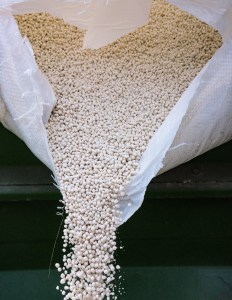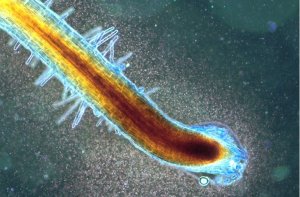With rising input costs putting a hardened focus on maximising the efficiency of nutrients applied to crops, biological aids could prove to be an important tool in the armoury. CPM speaks to the experts.
“With the price of nitrogen at the moment, efficiency is critical.”
By Charlotte Cunningham and Lucy de la Pasture
As fertiliser costs rose to new heights last season, ‘nitrogen use efficiency’ – or NUE as it is abbreviated to – spent much of 2022 trending on ag Twitter.
But the fundamentals and science behind NUE is far greater than just a Twitter trend and is imperative in getting good results for both crops and the wider environment when it comes to nitrogen applications.

Dr Mark Fletcher says it’s important to understand all the factors that can impact nitrogen use efficiency in order to improve it.
But to achieve, and eventually improve, NUE requires a methodical approach, starting with a sound understanding of the factors that can impact it, says Agrovista’s Dr Mark Fletcher, who is a specialist in plant physiology and nutrition. “One of the main things to start with is what we’re growing in – the soil. Factors like compaction, soil structure, soil type all have the potential to impact the efficiency of what you apply. Water content and availability is key too – if you have no water, you have no uptake.”
Nutrients, like sulphur and magnesium, will also affect how nitrogen is utilised by the plant, and so will previous cropping and how these factors may, or may not, have interacted with soil supplies of nutrients, he explains.
And then there are practical fertiliser decisions such as application timing and the type of fertiliser used – foliar or solid. “The timelier you can apply fertiliser, the better it is for efficiency,” adds Mark. “Foliar applied fertilisers can also be more efficient than solid. Practically, this means that if you applied at the correct timing, it could give you a higher protein yield because it’s more efficient. But the effect can be inconsistent depending on the year.”
Variety choice can also play an influential role in the efficiency – or not – of a crop. However, Mark says that varieties come in and out so quickly, that sustained, replicated scientific research to prove this is hard to achieve.
So with so many factors that could affect nutrient efficiency in the plant, how can growers practically tackle this on farm?
Mark believes that using biology is a good place to start. “If we’re using biology to improve nitrogen use efficiency, we’re using it to reduce reliance on fertiliser. If we can use biology to reduce and even substitute fertiliser input, then it’s likely we will at least save a few quid.” says Mark. “But with that, there’s a chance we could reduce reliance on pesticides, insecticide and herbicides too – so there’s an added benefit.”

Putting biology down in the root zone can aid the breakdown of nutrients and organic matter which are then re-released to the plant.
But the benefits go beyond just economics because plants also become more resilient when the right biology is used at the right time, he adds. “As a plant goes through its lifecycle, it can start to break down. Biology can be used to keep them ‘fitter’ for a bit longer and keep them going. This in turn might mean it’s less prone to fungal issues and pressure from pests, for example, which again reduces reliance on these inputs.”
Mark says that while carbon footprints are a ‘sexy’ topic at the moment, there’s a real tangible benefit on this front from optimising biology. “If we can use these products to reduce inputs and therefore the carbon footprint to grow crops more ‘ethically’, then that’s a benefit to everyone.”
Away from the plants themselves, using biology can also improve soil health and resilience, he adds. “Soils are very complex in terms of their interactions – there’s a lot of microbial and fungal mass down there which helps break down organic material with the soil and release it to the plant. So, allowing us to maximise that through biology can only be a good thing.
“Going back to fertiliser and inputs, ammonium nitrate is acidic up to a point. So, if we can reduce an acid going onto the crops then it’s going to be better for the environment and our ‘friends’ in the soil.”
The market offerings and their efficacy when it comes to biological products is also complex, but Mark has trialled and tested a suite of options from the Unium Bioscience stable over recent years, which he believes can all work scientifically to the benefit of both crops and the soil.
This includes Tiros – an endophyte seed treatment targeted specifically at fixing nitrogen from the atmosphere and sequestering other key nutrients from the soil. “How this is beneficial goes back to the advantages from having microbial mass in the root zone and breaking material down – it works in a similar way.”

A plethora of factors can influence nitrogen use efficiency in crops, from soil health and rainfall to fertiliser type and variety choice.
Mark adds that Tiros essentially helps ‘mine’ nitrogen from the soil which in turn reduces the reliance on bagged inputs, and also makes what is there much more available. “Improved nutrient supply also reduces stress in the plant. If the plant isn’t stressed and it’s getting the optimum amount of nutrients, then it can grow better.”
At the business-end of the season, this can translate into better results at harvest, he adds.
There’s more to NUE than enhanced uptake, the plant then has to utilise it. This is where T6P (trehalose-6-phosphate), can be useful. It’s a foliar product, applied typically around the T3 timing, explains Mark. “It works by relocating sugars from the ‘storage organs’ of the plant into the grain and ground to improve efficiency and uptake needed for growth by the plant. In work I’ve done with growers, we’ve found that you generally get a bigger grain – and yield with T6P.”
Tarbis is the foliar applied endophyte in the Unium portfolio and can be applied if Tiros hasn’t been used as a seed treatment. Though Mark hasn’t done much with this yet as it’s a fairly new-to-market product, he says that data suggests efficiency comes via improved yield. “The science behind this is a very interesting one, which requires a bit more work for us to fully understand.”
Twoxo XL is another option to enhance nutrient use via a unique signalling molecule which increases nitrogen assimilation in plants and up-regulates photosynthesis. The result is better NUE but also increased yield, which according to Agrovista trials is an average increase of 12% compared with untreated crops.
“Everything is always changing – whether it’s a loss of actives or a reduction in the number of fertilisers we can apply through legislative changes – so we have to start to look at these different areas and resources like biology and biostimulants products,” believes Mark. “There’s scientific background behind them and because of this, they have a place within the system which is going to become more important as we move into the future of farming.
“But it’s like anything, if you never try, then you’re never going to know.”
Rethinking crop nutrition

The importance of rhizophagy goes beyond the acquisition of nitrogen, plants receive all other essential plant nutrients, explains Sam Knowlton.
Plant nutrition is undergoing a revolution. The role of the soil microbiome in both making nutrient available to plants and nutrient acquisition is beginning to be appreciated, but it’s only in the past ten years that science has brought biology back to the forefront when it comes to plant nutrition.
Sam Knowlton of US-based company Soilsymbiotics explains that for the past century, agriculture has followed a chemical paradigm that has looked at plant nutrition as the interception and uptake of mineral ions by plant roots. But it’s actually a much more complex process.
“This linear and simplistic approach to farming leads to the over application of soluble fertilisers at the expense of the linchpin of soil and plant health — the invisible herd of soil microorganisms.”
As a result, the role of soil biology in nutrient cycling and how it interacts with plants had largely been ignored in plant nutrition, highlights Sam.
“Through the process of photosynthesis, plants produce energy in the form of sugar-rich exudates that are released into their root zone to attract and feed beneficial microorganisms. In turn, bacteria and fungi retain nutrients from the soil, which are made available to plants when a nematode or protozoa consumes them,” he explains.
“Aside from some specialised symbionts like mycorrhizal fungi and Rhizobium, this is the primary mode of nutrient cycling.”
Sam goes on to say that in 2013, a group of Australian scientists discovered a plant/microbe interaction that broke all of these rules and completely blurred the line between plants and their bacteria and fungi counterparts. This association between plants and microbes was named rhizophagy.
A few years later, Dr James White of Rutgers University discovered that rhizophagy is more than a one-off interaction. “It’s a recurring cycle with far reaching repercussions for plant health and the future of agriculture,” he says.

Plants initiate the rhizophagy cycle by attracting microbes into the root zone by exuding sugars, amino acids, organic acids, and fats, the microbial equivalent of a five-star buffet.
“Like other plant and microbe interactions in the soil, plants initiate the rhizophagy cycle by attracting microbes into the root zone by exuding sugars, amino acids, organic acids, and fats, the microbial equivalent of a five-star buffet.
“The microbes then colonise the root meristem, at which point they are ‘internalised’ into the root cells. In other words, the plant roots eat the microbes — specifically bacteria and some fungi.”
These microbes, now within the plant’s tissues, are known as endophytes, explains Sam. “Once inside the root, the endophytes are shuttled throughout the plant and exposed to reactive oxygen called superoxide that ruptures the microbe’s cell wall allowing the plant to harvest nutrients from the remaining protoplast.
“Some of the subsumed microbes survive the nutrient extraction process and begin to move throughout the plant. Some microbes are deposited up into the leaves, seeds and fruits. Others are cloned within the root where they spur the rapid growth and elongation of roots hairs.
“As the root hairs elongate, microbes are ejected back into the soil, along with a trail of exudates to feed them. While in the soil, microbes acquire more minerals nutrients and are then triggered to follow the exudate trail back to the plant root tips, and the cycle continues,” explains Sam.
The role endophytes can play in agriculture has attracted a lot of interest, particularly because it’s estimated that plants can acquire up to 30% of their nitrogen needs through the rhizophagy cycle.
“Given the steep economic and ecological costs associated with most nitrogen inputs, this free nitrogen source is a boon to farmers,” says Sam.
But the importance of rhizophagy goes beyond the acquisition of nitrogen. “It’s not just N, plants receive all other essential plant nutrients. With the rhizophagy cycle, plants have a vast menu of nutrients to choose from as needed. This is far superior to the conventional practice of force-feeding plants with soluble fertilisers.”
Sam also points to other advantages to the plant conferred by the rhizophagy cycle. “Through a unique mechanism, the endophytic bacteria involved in the rhizophagy cycle provide their host plant with heightened resistance to disease and pathogens. Essentially giving plants natural immunity for free and without the adverse side effects of chemical interventions.
“The big caveat is we’ve taken away the ability of plants and microbes to form rhizophagy symbiosis. Due to sterile plant breeding practices, overuse of chemical inputs, and other soil disturbances like frequent tillage, the link between plants and microbe symbionts is broken.”
Dr Nigel Grech, director of UK company Unium Bioscience, has spent much of his career as a university researcher studying agricultural biostimulants, biopesticides and sustainable nutritional efficiency in both plant and soil systems. Now concentrating on his own farming enterprise in California, he picks up on Sam’s point about breeding practices.
“In modern germplasm, a key is developing ‘clean’ tissue which typically means free of pathogens. A negative consequence of this is that you also eliminate all the “good” guys as well, just like when we take antibiotics and kill much of our beneficial gut microbes.”
So can this break in microbial associations that should begin with microbes on the seed be somehow ameliorated? Discoveries by Professor Sharon Doty, who has spent much of her career researching endophytes at the ‘Doty lab’ in University of Washington, have led to the identification of generalist strains of endophytic bacteria. Some of these have recently been incorporated into seed treatments and foliar sprays which can give crop plants a helping hand, explains Nigel.
But by supplying endophytes as a foliar or seed treatment, is this mimicking nature (ie reinstating a system the plant should have recruited itself?) or is it just a sticking plaster? “Our endophyte products, Tiros and Tarbis, contain two of the Doty bacterial strains and effectively augment nature,” believes Nigel.
“Endophytes have many known, and I’m sure unknown, mediation effects on plants. What they bring is balance. We know under certain stresses plants exude molecules to encourage microbial associations. Endophytes do this, for example, in eliciting plants to release more organic acids that encourage P solubilisation and microbial rhizosphere colonisation.”
Bioscience in practice
As the chemistry toolbox continues to shrink, a mesmerising array of new bio-solutions are coming to market, offering a range of benefits and complementary additions. Evaluating just how effective they are, and where they’re best placed can be tricky.
In 2021 CPM teamed up with Unium BioScience to open the science behind these innovations. In this third series of articles, we explore how bioscience can be utilised in the field, building on our understanding of the physiological processes and trials data. Above all, these articles give the grower an inside view on some of the exciting opportunities biosolutions offer in the field.
This first article in the series looks at how NUE can be improved by using biology and supporting it with specialist biostimulants. In the Unium programme, Tiros provides endophytes which fix nitrogen, giving plants a natural boost for life. Twoxo XL helps the plant assimilate that nitrogen, increasing its efficiency and 3-Alo T6P supports carbon sequestration and signals to the plant to enhance sugar metabolism and transport, which benefits both the crop and the endophytes.
This article was taken from the latest issue of CPM. For more articles like this, subscribe here.




